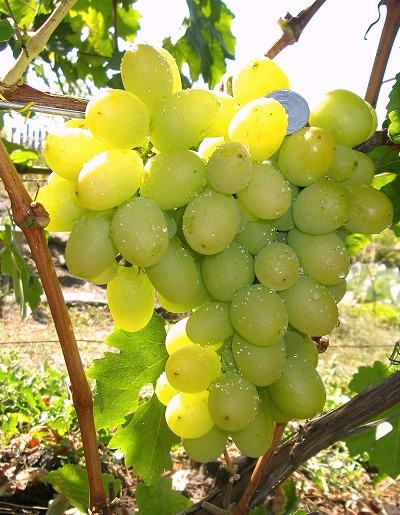
- Authors: Krainov Viktor Nikolaevich
- Appointment: dining room
- Berry color: amber with tan
- Taste: harmonious
- Ripening period: very early
- Ripening period, days: 95-100
- Frost resistance, ° C: -23
- Bunch weight, g: 700-1000
- Flower type: bisexual
- Tasting assessment, points: 8
The national breeder V.V.Krainov has created many varieties of table grapes with outstanding characteristics. He paid special attention to raising yields and breeding hybrids with early and very early ripening periods. One of the most successful is the First-Called grape.
Breeding history
Viktor Krainov worked in the Rostov region, and all the grape hybrids were tested by him in the climatic conditions of the south of Russia. The breeder chose the Talisman and Radiant raisins as the parents of the First-Called. The variety was created and tested in the 80s of the XX century. It can now be purchased at nurseries and online stores across the country.
Description
Table white grapes, medium vigorous. The bush of the First-Called has 55-60% of fruitful shoots, the fruiting coefficient is 1.0-1.3. This indicates a very high fruitfulness of the shoots and the potential yield of the variety, which are directly dependent on many factors: climatic conditions, correct pruning and cultivation techniques.
The leaf plate is medium in size, five-lobed, heart-shaped with varying degrees of dissection.
Pros of a hybrid:
very early ripening;
high tasting marks;
high sugar content;
good immunity to most grape diseases;
high transportability and marketability of fruits.
The downside is the average frost resistance.
The vine ripens well along its entire length during the season, the rooting of cuttings is successful.
Ripening period
A very early hybrid with a period from budding to full maturation - 95-100 days. In the climatic conditions of the Rostov region, the ripening of berries begins in late July - early August. In the regions located to the north, the ripening time is shifted. The sum of active temperatures for the onset of maturity of the First-Called is 2200-2400 ° C.
Bunches
Bunches of impressive size, medium density, weighing 700-1000 g, cone-shaped, sometimes cylindrical. Bunches remain on the bushes for a long time without losing their presentation.
Berries
Large, rounded, slightly elongated, golden-white, covered with a waxy coating, a pinkish tan and amber color appears in the sun. Rice fruits, without seeds. Average size 24-27x22-24 mm, weight from 10 to 12 g. Ripe berries contain 18-21% sugars, acidity 6-8 g / l.
Taste
Fruits with a pleasant harmonious taste, eaten by a thin skin, juicy, fleshy pulp. Tasters rate the taste of the grapes at 8 points.
Despite the fact that it is a table variety, from the First-Called one can get a worthy wine with a pleasant aroma, reminiscent of Riesling.
Yield
The hybrid is characterized by a high yield, according to gardeners, up to 10 kg per plant.
Winegrowers have found that feeding with nitrogen, phosphorus, potassium during the appearance of inflorescences and at the beginning of flowering increases the percentage of fruitful buds and the number of inflorescences on the vine next year. The most effective dressing before flowering in combination with pinching the tops of the shoots.


Growing features
The hybrid is undemanding to the composition of the soil. In fertile, abundantly humid areas, you can grow bushes with a luxurious green mass, large grapes. Problems with winter hardiness may arise - the vine enters a state of winter dormancy late. On dry soils, the fruits become smaller, the sugar content in them increases, the plants begin to prepare for winter earlier and the likelihood of freezing decreases.
The First-Called hybrid is sensitive to the illumination of the site by sunlight, protection from the winds is also desirable. The cultivation technique is reduced to weeding, loosening, watering and mulching the soil in the vineyard. An important technique for increasing drought and frost resistance of a culture is catarovka or removal of the upper (dew roots). It is carried out in the spring after the blooming of the bush, carefully dug in the bush and with a sharp, disinfected pruner, remove the surface roots growing at a depth of 20-25 cm. It is they who die in drought and freeze at the first freezing of the soil, weakening the plant. The procedure is quite complicated and novice growers should first study the technology of catarovka in theory.
Landing
You can plant seedlings of the First-Called hybrid in the spring, until the sap flow has begun, or in late autumn. Pits 70x80x70 cm are prepared in advance. A drainage layer is arranged at the bottom, then a layer of fertile soil, with organic fertilizers applied. A peg is installed for garter shoots. The roots of the seedling are carefully covered with soil mixture, watered, the soil is mulched.

Pollination
The flowers of the hybrid are bisexual, which facilitates pollination. The First-Called can act as a pollinator for grape varieties with a female flowering type.
Pruning
Performed to dose the load on the bush. As a result of pruning, 35-45 eyes should remain, fruit arrows are cut into 6-10 eyes, the fragment is carried out up to 30-35 green shoots.



Frost resistance and the need for shelter
The First-Called hybrid cannot boast of outstanding frost resistance, it can withstand temperatures down to -23 ° C, therefore, in central Russia, the crop is grown as a covering or in greenhouses.

Diseases and pests
The hybrid is complex-resistant, which means that it has group immunity to a number of fungal diseases. Resistance to mildew - 3.5 points, to gray rot, powdery mildew - 3.5-4.0 points. The First-Called is susceptible to powdery mildew.

If a grape is exposed to any disease or insect, this always affects its appearance.
Storage
Preserving grapes for a long time is a difficult task. First-called - an early variety and is not subject to long-term storage. In a cool place in boxes with openings for air access, fruits are stored for 7-10 days.











































































